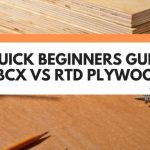So your new plywood sheets are too warped for use. Well, plywood can warp if humidity in your work shop is too high or a little moisture gets into it via those voids.
Plus, what makes warping even worse is heat from lights and other heating elements in your shop, leading to the wood expanding even more.
So is there really a type of plywood that doesn’t have a warping problem?
If you want plywood that doesn’t warp then Marine Plywood is a water resistant material that has been designed to be used on boats, and lake-side constructions. This nearly void-free plywood can withstand very wet and humid conditions. It can even handle being submerged in water without taking on moisture.
Now, I know what you are thinking… “You’re really telling me I can get plywood that won’t warp and will stand up to damp conditions?”
Yes, Marine Plywood can shrug off water with relative ease, but here is the catch… it is very expensive. And although it won’t fall apart in water, its price tag is just a little too high to ignore.
So, if marine plywood isn’t a viable option – what should you do? And what if there was a way to prevent regular hardwood plywood from warping in the first place?
Well, keep reading to find the answers to those questions below…

This post may contain affiliate links to products that we receive a commission for (at no additional cost to you). Learn more here.
Why Is My Plywood Warping?
Plywood warping is something that is a frequent problem faced by woodworkers. Long story short, warping generally happens when moisture gets trapped between layers of veneer, warping the entire plywood sheet.
Also, sometimes, warped plywood is caused by a simple increase of damp and humidity in the air around it. This is why you need to make sure that you purchase your plywood from reliable sources instead of just picking up some random boards from a local hardware shop.
What Type Of Plywood Is Least Likely To Warp?
Plywood made from seasoned Double Fir wood is less likely to warp than other plywood types. Which is why it is perfect for building structures that need to withstand moisture and weather exposure.
While other types of wood species continue to shrink and swell after seasoning, fir stays incredibly stable once it dries. Plus, it is moderately resistant to damage from rot, making it a good choice for outdoor decks and fences.
Besides considering wood species, you also need to think about the type of glue used to bond plywood veneers together.
Exterior graded plywood is special because it is made in a different way to typical plywood. How, you may ask? Well, for one, its layers are glued together using waterproof glue – this makes it perfect for outside use. Also, exterior grade plywood’s durability and sturdiness make it ideal for indoor use too in high humidity rooms (such as the kitchen or the bathroom).
So Douglas Fir Plywood, that has been bonded with exterior glue, is a fairly warp-resistant combination.
But, How Do You Prevent Plywood From Warping?
Warping in plywood can cause a host of problems. Anything from sagging shelves to uneven cabinetry can come about as a result of warped ply.
It doesn’t have to be this way though. And you don’t have to worry about all the potential problems that come from warping if you just properly store that plywood.
The solution is surprisingly simple: the most effective way to store plywood is by lying it flat. This method works because the moisture in the air can evenly distribute to all parts of the wood.
The best method is to store plywood flat by layering it on thick pieces of wooden blocks. That way you aren’t harming your plywood by having it sit directly on the floor.
Now, it is important to note that plywood will warp if it is in permanent contact with cement or concrete blocks. So make sure you avoid storing wood in direct contact with the ground (or up against a wall).
How Do You Keep Plywood From Warping When Painting?
Make sure you seal all of the ply sheets surfaces and edges. The front and back faces will need at least a couple coats of sealant, and you will need to apply more coats to really cover up those exposed edges.
Sealing up plywood is not hard to do, but it can be tedious and time consuming to get it done right. So, you can learn more about sealing plywood by checking out our beginners guide right here on The Woodwork Place. The article can be found by clicking here: ‘Beginners Guide To Plywood Sealer’.
How Do You Flatten Warped Plywood?
So that plywood sheet may have buckled, but you don’t need to bow to the pressure.
Most types of plywood will naturally shrink if left in less than ideal storage conditions. This is called bowing. It’s no reason for panic though. Your best option at this stage is to use hot water and a warm environment to help restore that plywood pliability. Just follow these 5 simple steps:
- STEP 1: Your first step is to dunk some tack cloths or a sponge in hot water.
- STEP 2: Apply that hot water to the concave curved side of the plywood until that side of the plywood is damp.
- STEP 3: Place the plywood board outside in the warm sunlight. And make sure that the damp side of the board is facing down towards dry ground.
- STEP 4: Next, place a few weighted blocks on top of the board. These blocks will place downward pressure on the upward curved section.
- STEP 5: Check the plywood board every 20 minutes to see if it has evened out. You will need to check it regularly to make sure that the plywood doesn’t over correct and warp the other way. It can take an hour or so to fully flatten out.
For a visual guide to this quick and easy solution to plywood warping, you can check out Mr P.’s simple 90 second video guide below:
Will A Plywood Door Warp?
Yes, a plywood door can warp. Plywood products are engineered with a core of cross-laminated layers of wood veneer. So whether you work with solid wood or plywood cabinet doors, often you will find yourself in a situation where one of your panels gets out of shape after a while. Especially if environmental factors occur such as moisture, heat and humidity build up in the air.
So In Conclusion
Anyone who has dealt with regular plywood knows it sometimes feels as though this engineered wood will warp if you even so much as look at it crooked.
But, as a marine building material, Marine Plywood is one type of plywood that can withstand very wet and humid conditions – and can happily stay submerged in water without taking on moisture.
And, if your budget won’t stretch to allow for marine ply, then some well sealed exterior grade plywood will do in a pinch.



